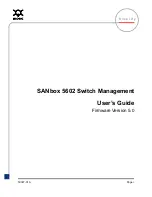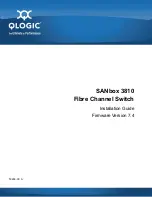
122
To define and view MAC Multicast groups:
1.
Click
Configuration > Multicast > MAC Group Address FDB
.
2.
Enter the parameters.
•
VLAN ID —Enter the VLAN ID of the group to be displayed.
•
MAC Group Address —Set the MAC address of the Multicast group to be
displayed. If no MAC Group Address is specified, the page contains all the MAC
Group Addresses from the selected VLAN.
3.
Click
Search
, and the MAC Multicast group addresses are displayed in the lower block.
Entries that were created both in this page and in the IP Group Address FDB page are
displayed. For those created in the IP Group Address FDB page, the IP addresses are
converted to MAC addresses.
4.
Click
Add
to add a static MAC Group Address.
5.
Enter the parameters.
•
VLAN ID — Defines the VLAN ID of the new Multicast group.
•
MAC Group Address — Defines the MAC address of the new Multicast group.
6.
Click
Apply
, the MAC Multicast group is saved to the Running Configuration file.
To configure and display the registration for the interfaces within the group, select an
address, and click
Membership
.
The MAC Group Address FDB page opens. Enter the following:
•
VLAN ID—The VLAN ID of the Multicast group.
•
MAC Group Address—The MAC address of the group.
•
Interface Type—Port or LAG.
7.
Click
Search
to display the port or LAG membership.
8.
Select the way that each interface is associated with the Multicast group:
•
Static—Attaches the interface to the Multicast group as a static member.
•
Dynamic—Indicates that the interface was added to the Multicast group as a
result of IGMP snooping.
•
Forbidden—Specifies that this port is not allowed to join this group on this VLAN.
•
Excluded—Specifies that the port is not currently a member of this Multicast
group on this VLAN.
9.
Click
Apply
, and the Running Configuration file is updated.
Note—
Entries that were created in the IP Group Address FDB page cannot be deleted in this
page (even if they are selected).
















































